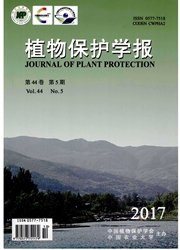

 中文摘要:
中文摘要:
通过田间接种诱发了不同等级的小麦条锈病,随着条锈病的传播,在不同的小区间形成病情梯度,利用ASD手持式地面非成像光谱仪(325~1075nm)测定不同生育期、不同病情指数的冬小麦冠层光谱反射率,并同步调查病情指数,进而对不同生育期、不同病情指数的小麦奈锈病冠层光谱反射率进行相关分析。结果表明,不同病情指数的冬小麦植株在600~703、770~930nm波段的冠层光谱反射率存在显著差异,并在波段770~930nm间,病情指数(DI)与光谱反射率呈显著负相关,负相关系数达到极显著;而在600~703nm间,病情指数与光谱反射率呈显著正相关,相关系数达到极显著。构建了3个生育期病情指数与650和850nm波段处的光谱反射率的回归方程:拔节期,DI=13.03×R650nm-0.67×R850nm+10.22(R^2=0.6570);灌浆期,DI=48.63×R650nm-2.41×R850nm-41.51(R^2=0.8196);乳熟期,DI=24.42×R650nm一5.10×R850nm+67.77(R^2=0.7336)。
 英文摘要:
英文摘要:
Three plots of wheat were inoculated with different amount of wheat stripe rust pathogens, with the disease spread, 25 plots were infected with different levels of the pathogens. Canopy reflectance of wheat in different times were measured with an ASD field spectral handheld sensor, meanwhile the DI (disease index) was also investigated. Results show that wheat stands with different disease levels indicated different reflection curves. We found that with the DI increase, canopy reflectance between 600 -703 nm decrease distinctively, and with the DI increase, canopy reflectance between 770 - 930 nm increase distinctively. So we built three regression models among DI and canopy reflectance at 650 nm, 850 nm wave band: at jointing stage, DI = 13.03 × R650nm - 0. 67 × R850nm + 10.22 (R^2 = 0. 6570) , at filling stage, DI = 48.63 × R650nm - 2.41 × R850nm - 41.51 ( R^2 = 0. 8196 ) , at milky stage, DI = 24.42 × R650nm -5. 10 × R850nm +67.77(R^2 =0. 7336).
 同期刊论文项目
同期刊论文项目
 同项目期刊论文
同项目期刊论文
 期刊信息
期刊信息
